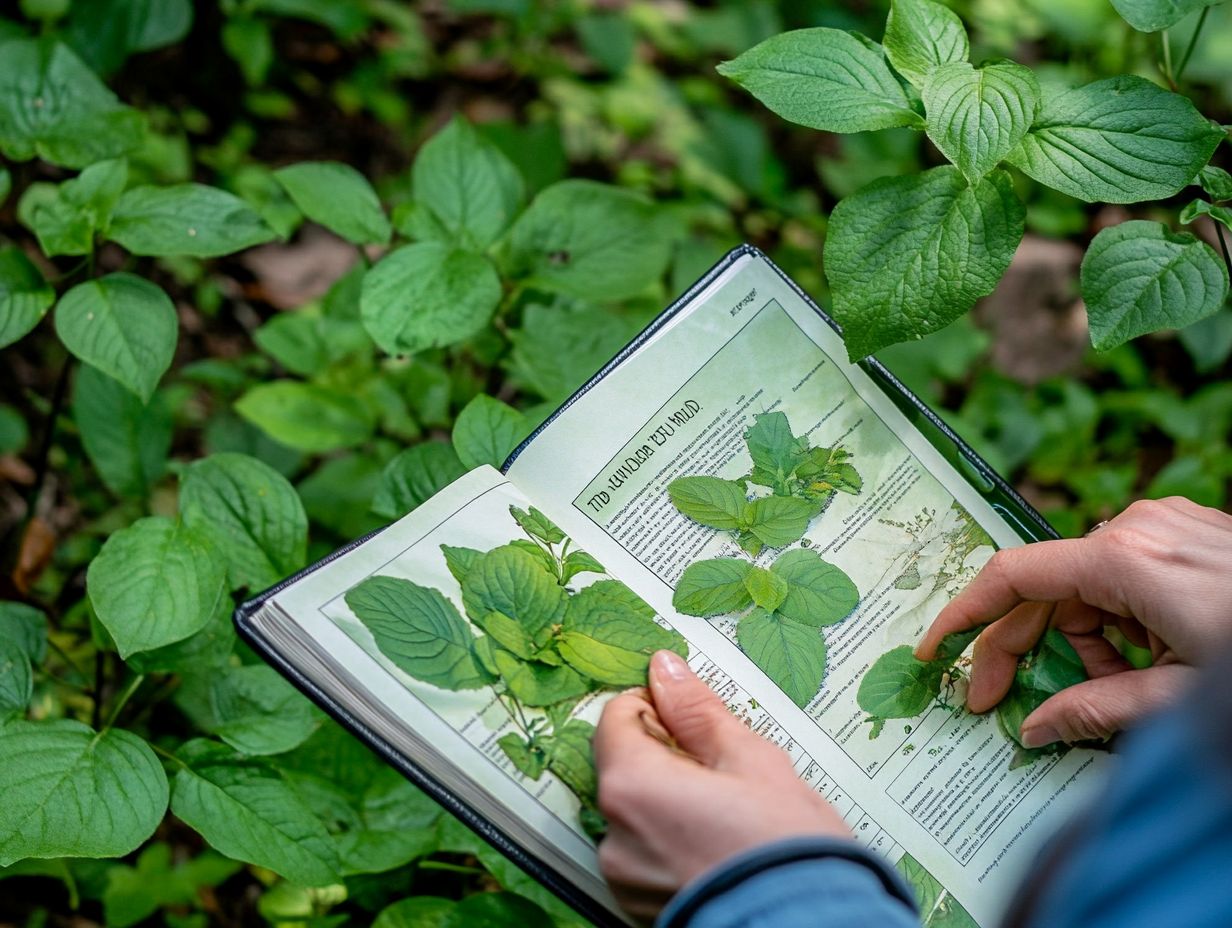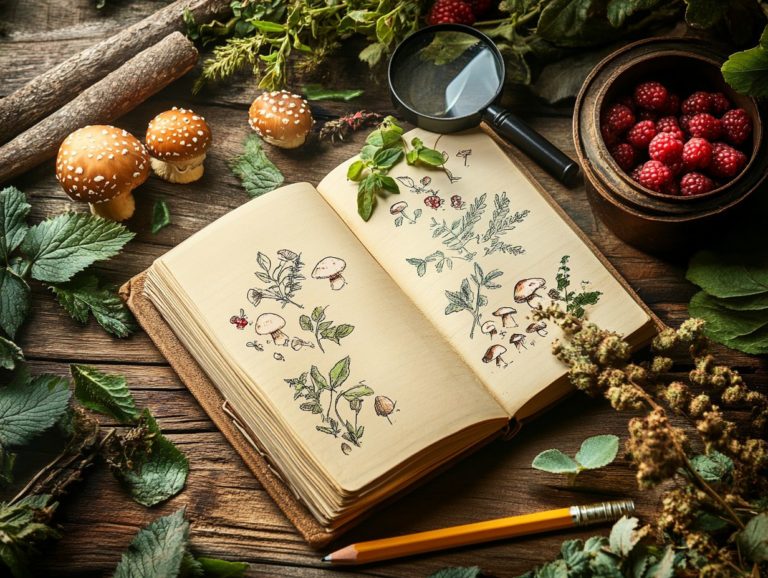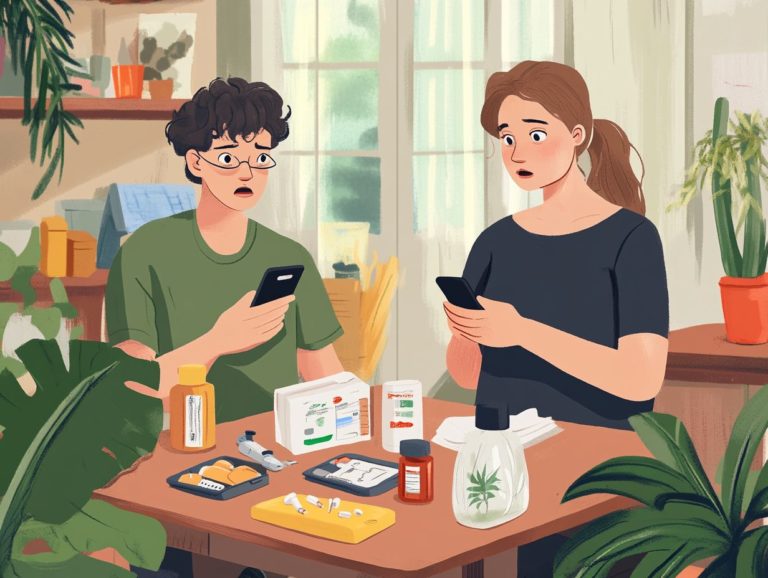How to Avoid Toxic Plants While Foraging?
Foraging for wild plants offers an exhilarating opportunity to immerse yourself in nature and uncover unique flavors. However, it s essential to recognize that this adventure comes with its own set of risks.
In this article, you ll delve into the potential dangers and health concerns associated with foraging. This includes tips on identifying toxic plants and their common characteristics. You ll also discover essential safety measures to prevent accidental ingestion, along with best practices for safe foraging.
If the thought of foraging feels overwhelming, alternative sources for wild edibles will also be highlighted.
Embark on this journey as you navigate the captivating yet cautious realm of foraging!
Contents
- Key Takeaways:
- The Risks of Foraging for Plants
- Identifying Toxic Plants
- Preventing Accidental Ingestion
- Safe Foraging Practices
- Alternative Sources for Foraged Foods
- Frequently Asked Questions
- How to Avoid Toxic Plants While Foraging?
- What are some common signs of toxic plants?
- How can I educate myself about toxic plants?
- Are there certain areas where I should avoid foraging?
- What precautions should I take while foraging?
- What are some common toxic plants that I should be aware of?
- What should I do if I accidentally ingest a toxic plant?
Key Takeaways:

- Always research and properly identify toxic plants before foraging to prevent accidental ingestion.
- Look for common characteristics of toxic plants, such as shiny leaves or thorns.
- Follow safety measures to stay safe while foraging for plants and consider alternative sources for wild edibles.
The Risks of Foraging for Plants
Foraging for plants can be an exhilarating journey into the heart of nature, presenting a chance to uncover a treasure trove of edible plants and wild foods.
However, it’s vital to be mindful of the inherent risks. The temptation to gather nutritious delights like wild berries and edible mushrooms is undeniable. As a novice forager, you must also acknowledge the lurking dangers of poisonous plants.
Varieties such as the Death Cap mushroom, Monkshood, and Hemlock pose serious health threats if mistaken for something else. Understanding these risks is essential to ensure your foraging adventures are safe and in line with sustainable practices, which means practices that do not harm the environment.
Potential Dangers and Health Concerns
The potential dangers of foraging go beyond the thrill of uncovering wild food; they include serious health risks associated with consuming poisonous plants.
This risk becomes particularly pronounced when you mistakenly identify toxic species, potentially leading to dire consequences. Take Oleander, for instance. While it may grace your garden with stunning flowers, it harbors potent compounds capable of disrupting heart function and can even be fatal if ingested. Similarly, encountering Poison Ivy can lead to debilitating skin reactions, causing intense discomfort and the possibility of infection.
Equip yourself with knowledge to stay safe and thrive! It s crucial to understand the distinguishing features of edible versus toxic species. Carry reliable field guides and, when in doubt, consult experienced foragers or local experts. Such precautions are essential for ensuring your safety and promoting responsible foraging practices.
Identifying Toxic Plants
Identifying toxic plants is an essential skill for anyone involved in foraging, as misidentification can lead to significant health risks. Numerous plants, like Jerusalem Cherry and Doll’s Eyes, have traits that might easily be mistaken for their edible counterparts.
Therefore, gaining a thorough understanding of the common features and characteristics of toxic plants is crucial for ensuring your safety during foraging excursions, as well as learning how to spot edible plants in the wild.
Common Features and Characteristics

Common features of toxic plants often showcase distinct leaf shapes, vibrant flower colors, and unique growth habits. It is essential for you to enhance your plant identification skills.
Take Horse Nettle, for example. Its spiny leaves and bell-shaped purple flowers that bloom in summer serve as a warning, while those yellow berries can be dangerously misleading if you mistake them for something edible. Then there s Lantana, flaunting its eye-catching clusters of orange, yellow, and pink flowers, yet harboring a treacherous secret: its berries are highly toxic when consumed.
By dedicating time to learn about these perilous plants and consulting reliable identification guides, you can sharpen your eye and adopt a safer approach to foraging. Understanding how to spot edible vs. poisonous plants ensures that your adventures in nature’s bounty can remain enjoyable rather than hazardous.
Now, get out there and discover the amazing world of foraging safely!
Preventing Accidental Ingestion
Preventing the accidental ingestion of toxic plants is crucial for anyone who enjoys foraging. To ensure safety, it’s important to learn how to handle wild edibles safely, as a single misstep can lead to serious health risks!
By implementing effective safety measures and following key foraging tips, get ready to confidently explore nature’s bounty while minimizing the chances of encountering poisonous plants. For more detailed guidance, check out how to identify safe wild edibles. This approach ensures your adventures in the wild are both enjoyable and safe, allowing you to fully experience the rewards that nature has to offer.
Safety Measures and Tips
Implementing effective safety measures while foraging is essential. You ll find a wealth of tips to ensure your experience in the wild is both safe and enjoyable.
Foraging in groups is highly recommended. It not only enhances your safety but also fosters friendship and community among participants. Engaging with experienced foragers can significantly improve your identification skills and help you avoid mistaking one plant for another.
Utilize reliable resources, such as field guides or mobile identification apps, to verify the safety of what you re harvesting. Being aware of your personal health considerations, like allergies or medical conditions, is vital for a secure foraging experience.
Understanding the potential risks associated with foraged food turns your adventure into not just a delightful outing but also a safe exploration of nature’s food.
Safe Foraging Practices
Embracing safe foraging practices is vital not only for your personal health but also for the sustainability of wild food sources for generations to come. By engaging in responsible plant harvesting methods and respecting local flora, you play a crucial role in maintaining ecological balance.
Expanding your foraging knowledge enriches your experience and enhances your appreciation of the nutritious plants that nature has to offer.
Best Practices for Avoiding Toxic Plants

Adopting best practices for avoiding toxic plants is essential for anyone interested in foraging, including understanding how to distinguish edible from poisonous plants. It significantly reduces the risks associated with misidentification.
To truly savor the rewards of foraging, familiarize yourself with local flora and employ various strategies to distinguish safe species from harmful ones. One effective method is to consult regional field guides that describe plant characteristics, ensuring you can identify them accurately.
Joining local foraging groups offers invaluable insights and firsthand experiences from seasoned enthusiasts. It’s also crucial to observe the growth habits and environments of plants. For instance, many toxic varieties thrive in wet, shaded areas. Understanding a plant’s habitat will greatly enhance your ability to gather edible options while skillfully avoiding potential hazards.
Alternative Sources for Foraged Foods
Exploring alternative sources for foraged foods can elevate your culinary experiences while deepening your understanding of the wild edibles and health benefits in your area.
As you diversify your diet with nutritious plants like Amaranth which is not only nutritious but also versatile in cooking and Pine nuts, you ll come to appreciate the rich tapestry of food systems that nature offers. This not only enhances your meals but also adds an exciting dimension to your foraging adventures!
Other Options for Wild Edibles
Discovering wild edibles can turn your meals into a delightful experience! You have a world of wild edibles at your fingertips, far beyond the usual foraged plants, ready to elevate your cooking journeys.
Consider the vibrant wildflowers like dandelions and violets. They don t just add a delightful burst of color to your salads; they also bring unique flavors and health benefits that can transform your meals.
You might also enjoy foraging (the act of searching for and gathering wild food) for edible seeds such as wild mustard and plantain, which lend a nutty richness that can enhance your dishes beautifully.
Explore foraging guides and workshops to learn more about identifying these plants and exploring their culinary uses. This way, you can fully embrace the bountiful offerings of nature.
Plus, connecting with local foraging communities can enrich your experience, providing invaluable insights and recipes that will make your wild food discoveries even more rewarding.
Frequently Asked Questions
How to Avoid Toxic Plants While Foraging?

When foraging for wild plants, knowing how to forage edible plants safely is crucial. Here are some frequently asked questions about how to avoid toxic plants while foraging.
What are some common signs of toxic plants?
Toxic plants may have bright or unusual colors, a strong odor, or a bitter taste. They may also have thorns or prickly hairs on their leaves or stems. It’s important to research and become familiar with the appearance of toxic plants in your area.
How can I educate myself about toxic plants?
The best way to educate yourself about toxic plants is to consult with a local expert or take a foraging class. Additionally, you should consider what wildlife to consider while foraging. You can also do research online or refer to field guides and apps that can help you identify and avoid toxic plants.
Are there certain areas where I should avoid foraging?
Avoid foraging near roadsides, industrial areas, or places where pesticides or other chemicals are used, as these areas may have higher levels of toxic plants. For more information, consider these safety tips for foraging. It’s also important to avoid areas with known toxic plants, such as poison ivy or poison oak.
What precautions should I take while foraging?
Always wear gloves and long sleeves to protect yourself from potential contact with toxic plants. Additionally, understanding the difference between edible vs. toxic plants is crucial, so be sure to properly wash and cook any foraged plants before consuming them.
What are some common toxic plants that I should be aware of?
Some common toxic plants include poison ivy, poison oak, poison sumac, foxglove, and hemlock. Again, it’s important to research and become familiar with the toxic plants in your area.
What should I do if I accidentally ingest a toxic plant?
If you suspect that you have ingested a toxic plant, get medical help right away! It’s important to know the symptoms of plant poisoning and to inform medical professionals of the plant you may have ingested.






